 | |
| Authors | Marc Summerlott and Bob Bledsaw |
|---|---|
| First published | 1978 |
Citadel of Fire is an adventure for fantasy role-playing games published by Judges Guild in 1978.
 | |
| Authors | Marc Summerlott and Bob Bledsaw |
|---|---|
| First published | 1978 |
Citadel of Fire is an adventure for fantasy role-playing games published by Judges Guild in 1978.
Citadel of Fire is an adventure scenario intended for high-level player characters that takes place in a five-level dungeon located under the castle of a wizard. [1]
Citadel of Fire is an adventure set in the Wizard's Tower consisting of 6 tower floors and a large 5-level dungeon. The adventure details each of the rooms and other features and includes a brief historical note to assist the Dungeon Master in determining how to run the scenario. [2]
Citadel of Fire was written by Marc Summerlott and Bob Bledsaw, and was published by Judges Guild in 1978 as a 32-page book. [1]
A cumulative sales listing shows that Citadel of Fire sold over 15,000 units by 1981. [3] : 200
Don Turnbull reviewed Citadel of Fire for White Dwarf #9, and rated it a 6 out of 10. [2] He commented that "Seeing – and being enormously impressed by – the recent TSR modules has rather spoiled me! In fact the outstanding quality of the TSR modules puts others into perspective as presentable, workable settings but not blessed with the thorough and meticulous approach which a product of outstanding quality must possess. The designer has done a workmanlike job, but I can't help feeling that there should by now be a number of 'amateur' designers who regularly produce scenarios of equal quality for the limited audience of their own players – things have progressed a great deal since Judges' Guild material first came on the market, yet the products of the Guild have remained at about the same quality level." [2] He continued by saying "To a novice designer – particularly one not yet ready for the sophisticated, complexity and toughness of the TSR Modules [...] this will be a useful addition to the collection and a helpful guide to design. To those who can now count themselves as veterans this may appear as rather run-of-the-mill with little to justify the cost. For the player, it is quite a simple dungeon/setting to explore apart from the areas containing the Demons". [2] Turnbull concluded his review by saying, "A useful product but not one which can now attract the praise which would have been heaped on it two years ago." [2]
Patrick Amory reviewed Citadel of Fire for Different Worlds magazine and stated that "This one is another of the Guild's earlier releases. Based on an evil wizard's tower, it is a typical D&D adventure, with nothing special to single it out from the crowd. A competent GM should be able to turn out one of these with his eyes closed." [4]
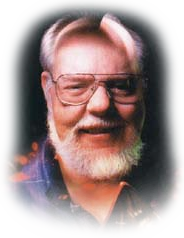
David Lance Arneson was an American game designer best known for co-developing the first published role-playing game (RPG), Dungeons & Dragons, with Gary Gygax, in the early 1970s. Arneson's early work was fundamental to the role-playing game (RPG) genre, pioneering devices now considered to be archetypical, such as cooperative play to develop a storyline instead of individual competitive play to "win" and adventuring in dungeon, town, and wilderness settings as presented by a neutral judge who doubles as the voice and consciousness of all characters aside from the player characters.
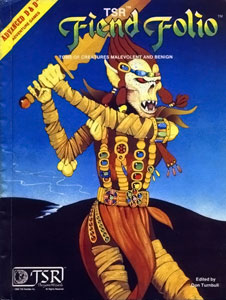
Fiend Folio is the name of three separate products published for successive editions of the fantasy role-playing game Dungeons & Dragons (D&D). All three are collections of monsters.
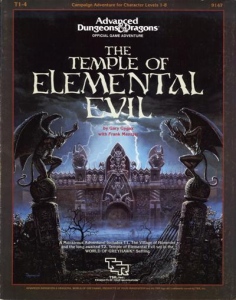
The Temple of Elemental Evil is an adventure module for the fantasy role-playing game Dungeons & Dragons, set in the game's World of Greyhawk campaign setting. The module was published by TSR, Inc. in 1985 for the first edition Advanced Dungeons & Dragons rules. It was written by Gary Gygax and Frank Mentzer, and is an expansion of an earlier Gygax module, The Village of Hommlet. The Temple of Elemental Evil is also the title of a related 2001 Thomas M. Reid novel and an Atari computer game.

Tomb of Horrors is an adventure module written by Gary Gygax for the Dungeons & Dragons (D&D) role-playing game. It was originally written for and used at the 1975 Origins 1 convention. Gygax designed the adventure both to challenge the skill of expert players in his own campaign and to test players who boasted of having mighty player characters able to best any challenge. The module, coded S1, was the first in the S-series, or special series of modules. Several versions of the adventure have been published, the first in 1978, and the most recent, for the fifth edition of D&D, in 2017 as one of the included adventures in Tales from the Yawning Portal. The module also served as the basis for a novel published in 2002.

In Search of the Unknown is a module for the Dungeons & Dragons roleplaying game, designed for use with the Basic Set of rules. It was written by game designer Mike Carr and was first published in 1978 by TSR, Inc. The module details a hidden complex known as the Caverns of Quasqueton. Reviewers considered it a good quality introduction to the game that was written in the so-called dungeon crawl style, where the primary goal of the players is the exploration of a dangerous labyrinth to battle monsters and obtain treasure.

Scourge of the Slave Lords (A1–4) is an adventure module for the Dungeons & Dragons fantasy role-playing game, published by TSR, Inc. in 1986. It combines the contents of four earlier modules, all set in the World of Greyhawk campaign setting and intended for use with Advanced Dungeons & Dragons first edition rules.

Descent Into the Depths of the Earth is an adventure module for the Dungeons & Dragons (D&D) fantasy roleplaying game coded D1–2. It was written by Gary Gygax, and combines two previously published modules from 1978, the original Descent into the Depths of the Earth and Shrine of the Kuo-Toa. A sequel to the first two modules, Vault of the Drow, was also published in 1978. All of these D-series modules were produced for use with the 1st edition Advanced Dungeons & Dragons (AD&D) rules.
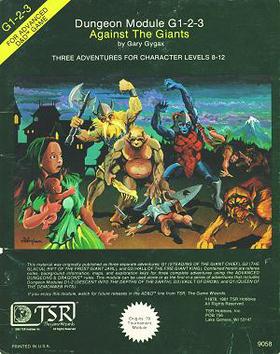
Against the Giants is an adventure module written by Gary Gygax and published by TSR in 1981 for the Dungeons & Dragons fantasy role-playing game. It combines the G series of modules previously published in 1978: Steading of the Hill Giant Chief, Glacial Rift of the Frost Giant Jarl, and Hall of the Fire Giant King. All three were produced for use with the 1st edition Advanced Dungeons & Dragons rules. In 1999, to recognize the 25th anniversary of TSR, the company released an updated version, Against the Giants: The Liberation of Geoff. Later in 1999, Wizards of the Coast published a novelization of Against the Giants by Ru Emerson.

City State of the Invincible Overlord is a fantasy role-playing game supplement originally published by Judges Guild in 1976. It was the first published fantasy role-playing game city setting, designed for use with Dungeons & Dragons (D&D), and officially approved for use with D&D from 1976 through 1983. It was later republished under license by Necromancer Games.
The DL series is a series of adventures and some supplementary material for the Advanced Dungeons & Dragons role playing game. These modules along with the Dragonlance Chronicles trilogy of novels, which follow one possible adventure series through the modules, were the first published items that established the Dragonlance fictional universe. The original DL series was released from 1984 to 1986, with the final two modules added to it in 1988. In the 1990s these roleplaying adventures from the original series were collected and revised for 2nd Edition AD&D as the three DLC Dragonlance Classics modules. There were also versions of the module series released in 1999, 2000 and 2006.
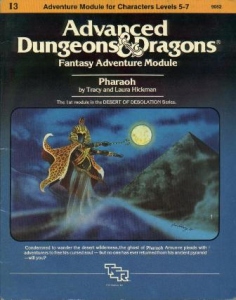
Desert of Desolation is a compilation adventure module published by TSR for the Dungeons & Dragons (D&D) fantasy roleplaying game. It combines three previously published individual modules: Pharaoh, Oasis of the White Palm, and Lost Tomb of Martek. The modules were made for use with the first edition Advanced Dungeons & Dragons (AD&D) rules. Pharaoh was created by Tracy and Laura Hickman soon after the couple married in 1977, and published by TSR in 1982. Oasis of the White Palm was a collaboration between Tracy Hickman and Philip Meyers, and Hickman wrote the Lost Tomb of Martek on his own; both were printed in 1983.

Jennell Allyn Jaquays was an American game designer, video game artist, and illustrator of tabletop role-playing games (RPGs). Her notable works include the Dungeons & Dragons modules Dark Tower and Caverns of Thracia for Judges Guild; the development and design of conversions on games such as Pac-Man and Donkey Kong for Coleco's home arcade video game system; and more recent design work, including the Age of Empires series, Quake II, and Quake III Arena. One of her best known works as a fantasy artist is the cover illustration for TSR's Dragon Mountain adventure.

Dark Tower is an adventure module published by Judges Guild in 1980 for the Advanced Dungeons & Dragons fantasy role-playing game.

A gamemaster's screen, also called a GM's screen, is a gaming accessory, usually made out of either cardboard or card stock, and is used by the gamemaster to hide all the relevant data related to a tabletop role-playing game session from the players in order to not spoil the plot of the story. It also hides any dice rolls made by the gamemaster that players should not see. In addition, screens often have essential tables and information printed on the inside for the gamemaster to easily reference during play.
Campaign Hexagon System is a book guide published by Judges Guild in 1977 for the Dungeons & Dragons game.
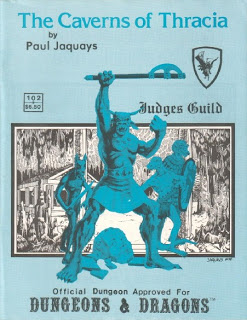
The Caverns of Thracia is an adventure for fantasy role-playing games published by Judges Guild in 1979. Written by Jennell Jaquays, it was compatible with Dungeons & Dragons. A revised edition—compatible with Dungeons & Dragons 3.5 edition—was published in 2004.

The Dragon Crown is an adventure for fantasy role-playing games published by Judges Guild in 1979.
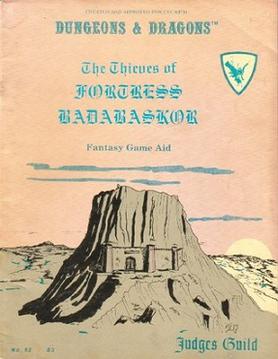
The Thieves of Fortress Badabaskor is an adventure for fantasy role-playing games published by Judges Guild in 1978.

Tegel Manor is a 1977 fantasy role-playing game adventure published by Judges Guild.
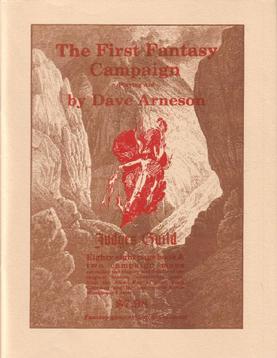
The First Fantasy Campaign is a supplement for fantasy role-playing games written by Dave Arneson and published by Judges Guild in 1977.